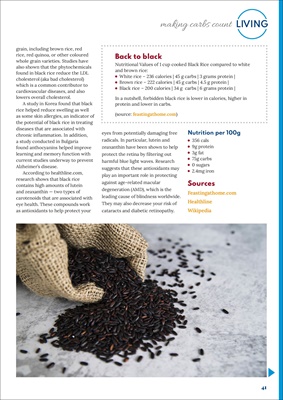
41
LIVING
making carbs count
grain, including brown rice, red
rice, red quinoa, or other coloured
whole grain varieties. Studies have
also shown that the phytochemicals
found in black rice reduce the LDL
cholesterol (aka bad cholesterol)
which is a common contributor to
cardiovascular diseases, and also
lowers overall cholesterol.
A study in Korea found that black
rice helped reduce swelling as well
as some skin allergies, an indicator of
the potential of black rice in treating
diseases that are associated with
chronic inflammation. In addition,
a study conducted in Bulgaria
found anthocyanins helped improve
learning and memory function with
current studies underway to prevent
Alzheimer's disease.
According to healthline.com,
research shows that black rice
contains high amounts of lutein
and zeaxanthin - two types of
carotenoids that are associated with
eye health. These compounds work
as antioxidants to help protect your
eyes from potentially damaging free
radicals. In particular, lutein and
zeaxanthin have been shown to help
protect the retina by filtering out
harmful blue light waves. Research
suggests that these antioxidants may
play an important role in protecting
against age-related macular
degeneration (AMD), which is the
leading cause of blindness worldwide.
They may also decrease your risk of
cataracts and diabetic retinopathy.
Back to black
Nutritional Values of 1 cup cooked Black Rice compared to white
and brown rice:
White rice - 236 calories | 45 g carbs | 3 grams protein |
Brown rice - 222 calories | 45 g carbs | 4.5 g protein |
Black rice - 200 calories | 34 g carbs | 6 grams protein |
In a nutshell, forbidden black rice is lower in calories, higher in
protein and lower in carbs.
(source: feastingathome.com)
Nutrition per 100g
356 cals
9g protein
3g fat
75g carbs
0 sugars
2.4mg iron
Sources
Feastingathome.com
Healthline
Wikipedia